2017 Hyundai Elantra isofix
[x] Cancel search: isofixPage 63 of 571

2-36
Safety system of your vehicle
Children always in the rear
seat
Children under age 13 must always
ride in the rear seats and must
always be properly restrained to min-
imise the risk of injury in an accident,
sudden stop or sudden manoeuvre.
According to accident statistics, chil-
dren are safer when properly
restrained in the rear seats than in
the front seat. Children too large for a
Child Restraint System must use the
seat belts provided.
Most countries have Child Restraint
System laws which require children
to travel in approved Child Restraint
Systems. The laws governing the
age or height/weight restrictions at
which seat belts can be used instead
of Child Restraint Systems differs
between countries, so you should be
aware of the specific requirements in
your country, and where you are trav-
elling.
Child Restraint Systems must be
properly placed and installed in the
rear seat. You must use a commer-
cially available Child Restraint
System that meets the requirements
of the Australian/New Zealand stan-
dards.
Child Restraint Systems are general-
ly designed to be secured in a vehi-
cle seat by lap belt or the lap belt
portion of a lap/shoulder belt and a
top tether anchorage, or by ISOFIX
lower anchorages and a top tether
anchorage, in the rear seats of the
vehicle.
CCHHIILLDD RREESSTTRRAAIINNTT SSYYSSTTEEMM ((CCRRSS))
Always properly restrain chil-
dren in the rear seats of the
vehicle, unless the air bag on
the front passenger seat is
deactivated.
Children of all ages are safer
when restrained in the rear seat.
A child riding in the front pas-
senger seat can be forcefully
struck by an inflating air bag
resulting in SERIOUS INJURY
or DEATH.
WA R N I N G
Page 64 of 571
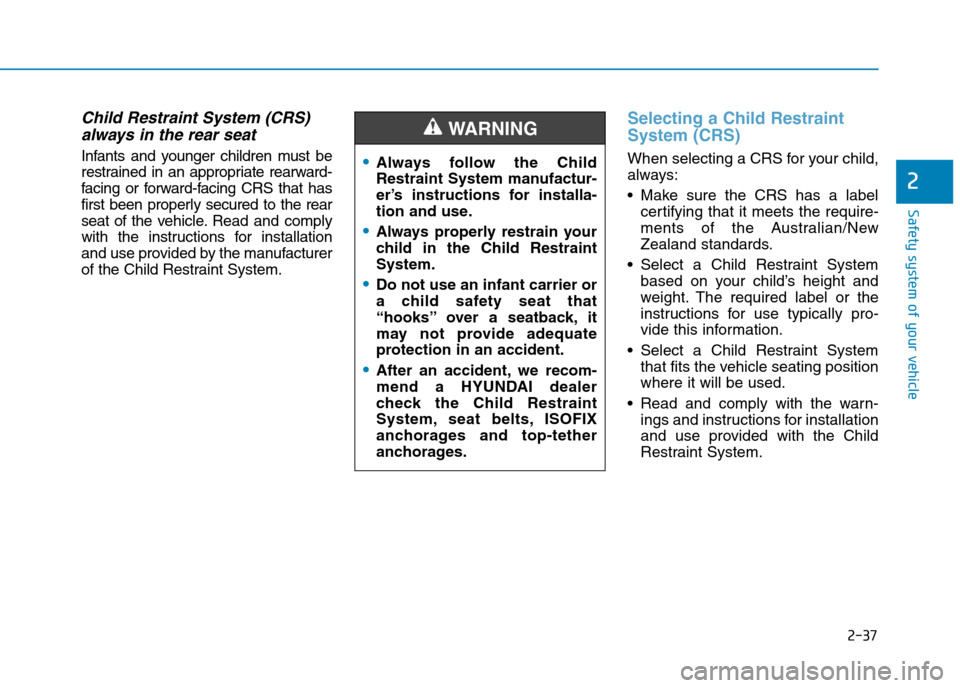
2-37
Safety system of your vehicle
Child Restraint System (CRS)
always in the rear seat
Infants and younger children must be
restrained in an appropriate rearward-
facing or forward-facing CRS that has
first been properly secured to the rear
seat of the vehicle. Read and comply
with the instructions for installation
and use provided by the manufacturer
of the Child Restraint System.
Selecting a Child Restraint
System (CRS)
When selecting a CRS for your child,
always:
•Make sure the CRS has a label
certifying that it meets the require-
ments of the Australian/New
Zealand standards.
•Select a Child Restraint System
based on your child’s height and
weight. The required label or the
instructions for use typically pro-
vide this information.
•Select a Child Restraint System
that fits the vehicle seating position
where it will be used.
•Read and comply with the warn-
ings and instructions for installation
and use provided with the Child
Restraint System.
2
•Always follow the Child
Restraint System manufactur-
er’s instructions for installa-
tion and use.
•Always properly restrain your
child in the Child Restraint
System.
•Do not use an infant carrier or
a child safety seat that
“hooks” over a seatback, it
may not provide adequate
protection in an accident.
•After an accident, we recom-
mend a HYUNDAI dealer
check the Child Restraint
System, seat belts, ISOFIX
anchorages and top-tether
anchorages.
WA R N I N G
Page 67 of 571
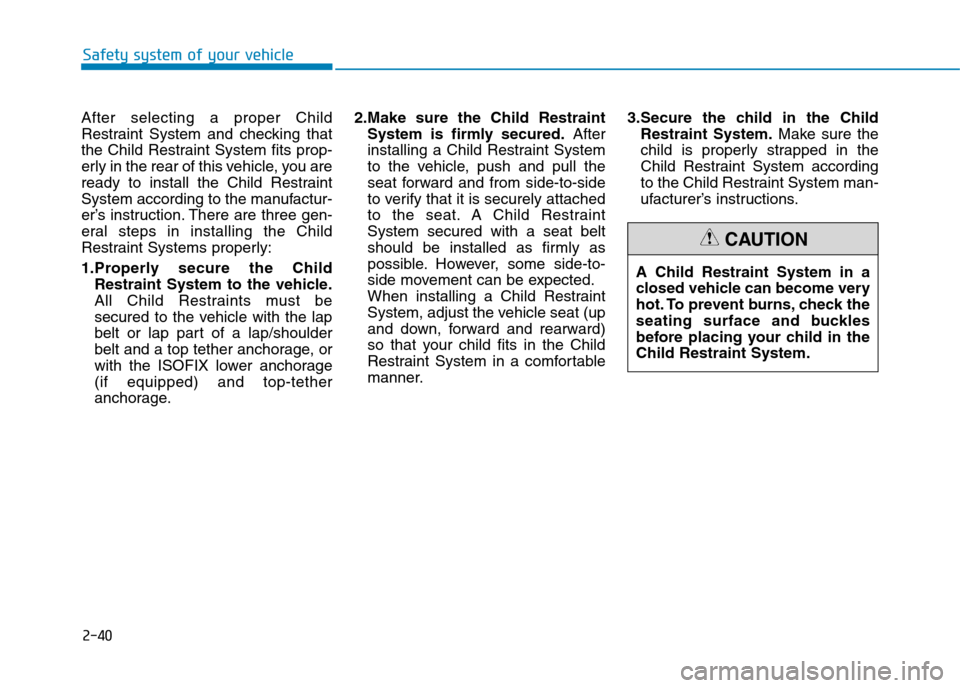
2-40
Safety system of your vehicle
After selecting a proper Child
Restraint System and checking that
the Child Restraint System fits prop-
erly in the rear of this vehicle, you are
ready to install the Child Restraint
System according to the manufactur-
er’s instruction. There are three gen-
eral steps in installing the Child
Restraint Systems properly:
1.Properly secure the Child
Restraint System to the vehicle.
All Child Restraints must be
secured to the vehicle with the lap
belt or lap part of a lap/shoulder
belt and a top tether anchorage, or
with the ISOFIX lower anchorage
(if equipped) and top-tether
anchorage.
2.Make sure the Child Restraint
System is firmly secured.After
installing a Child Restraint System
to the vehicle, push and pull the
seat forward and from side-to-side
to verify that it is securely attached
to the seat. A Child Restraint
System secured with a seat belt
should be installed as firmly as
possible. However, some side-to-
side movement can be expected.
When installing a Child Restraint
System, adjust the vehicle seat (up
and down, forward and rearward)
so that your child fits in the Child
Restraint System in a comfortable
manner.
3.Secure the child in the Child
Restraint System.Make sure the
child is properly strapped in the
Child Restraint System according
to the Child Restraint System man-
ufacturer’s instructions.
A Child Restraint System in a
closed vehicle can become very
hot. To prevent burns, check the
seating surface and buckles
before placing your child in the
Child Restraint System.
CAUTION
Page 68 of 571
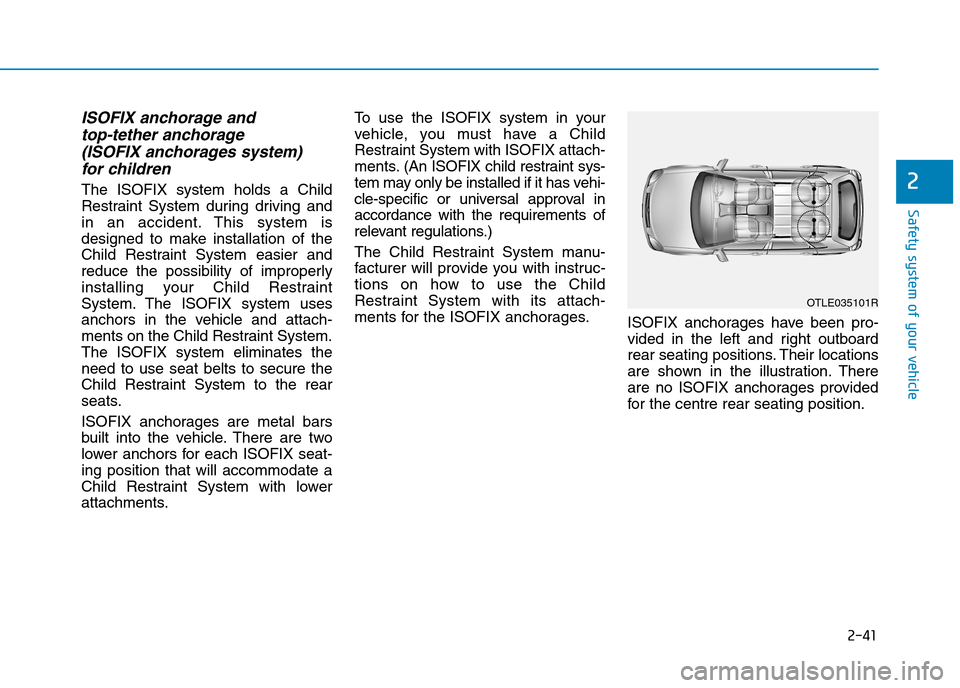
2-41
Safety system of your vehicle
2
ISOFIX anchorage and
top-tether anchorage
(ISOFIX anchorages system)
for children
The ISOFIX system holds a Child
Restraint System during driving and
in an accident. This system is
designed to make installation of the
Child Restraint System easier and
reduce the possibility of improperly
installing your Child Restraint
System. The ISOFIX system uses
anchors in the vehicle and attach-
ments on the Child Restraint System.
The ISOFIX system eliminates the
need to use seat belts to secure the
Child Restraint System to the rear
seats.
ISOFIX anchorages are metal bars
built into the vehicle. There are two
lower anchors for each ISOFIX seat-
ing position that will accommodate a
Child Restraint System with lower
attachments.
To u s e t h e I S O F I X s y s t e m i n y o u r
vehicle, you must have a Child
Restraint System with ISOFIX attach-
ments.(An ISOFIX child restraint sys-
tem may only be installed if it has vehi-
cle-specific or universal approval in
accordance with the requirements of
relevant regulations.)
The Child Restraint System manu-
facturer will provide you with instruc-
tions on how to use the Child
Restraint System with its attach-
ments for the ISOFIX anchorages.ISOFIX anchorages have been pro-
vided in the left and right outboard
rear seating positions. Their locations
are shown in the illustration. There
are no ISOFIX anchorages provided
for the centre rear seating position.
OTLE035101R
Page 69 of 571
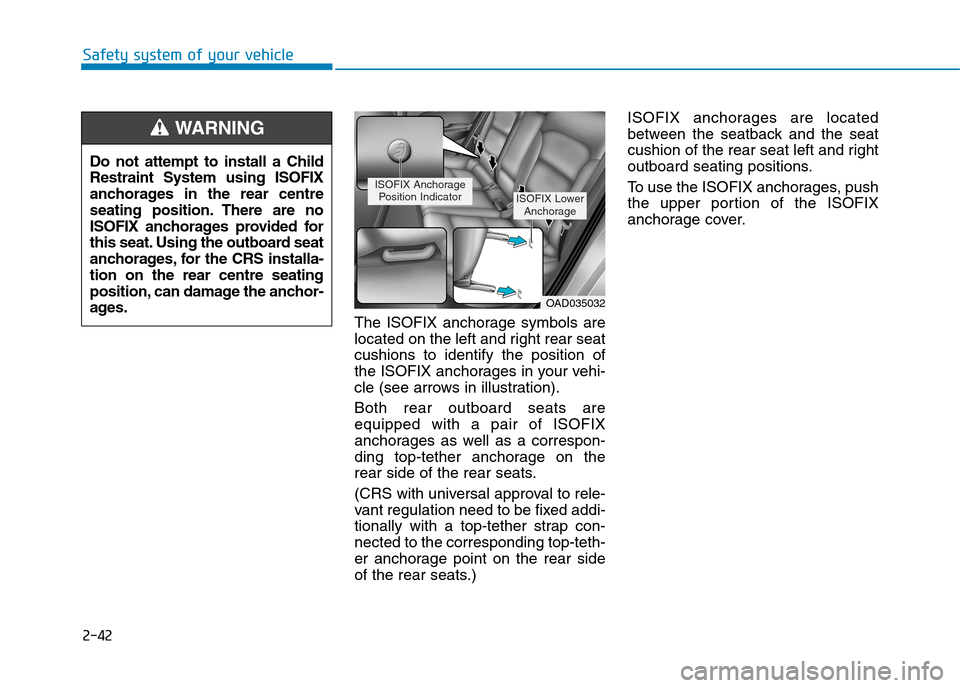
2-42
Safety system of your vehicle
The ISOFIX anchorage symbols are
located on the left and right rear seat
cushions to identify the position of
the ISOFIX anchorages in your vehi-
cle (see arrows in illustration).
Both rear outboard seats are
equipped with a pair of ISOFIX
anchorages as well as a correspon-
ding top-tether anchorage on the
rear side of the rear seats.
(CRS with universal approval to rele-
vant regulation need to be fixed addi-
tionally with a top-tether strap con-
nected to the corresponding top-teth-
er anchorage point on the rear side
of the rear seats.)
ISOFIX anchorages are located
between the seatback and the seat
cushion of the rear seat left and right
outboard seating positions.
To u s e t h e I S O F I X a n c h o r a g e s , p u s h
the upper portion of the ISOFIX
anchorage cover.
OAD035032
ISOFIX AnchoragePosition IndicatorISOFIX LowerAnchorage
Do not attempt to install a Child
Restraint System using ISOFIX
anchorages in the rear centre
seating position. There are no
ISOFIX anchorages provided for
this seat. Using the outboard seat
anchorages, for the CRS installa-
tion on the rear centre seating
position, can damage the anchor-
ages.
WA R N I N G
Page 70 of 571
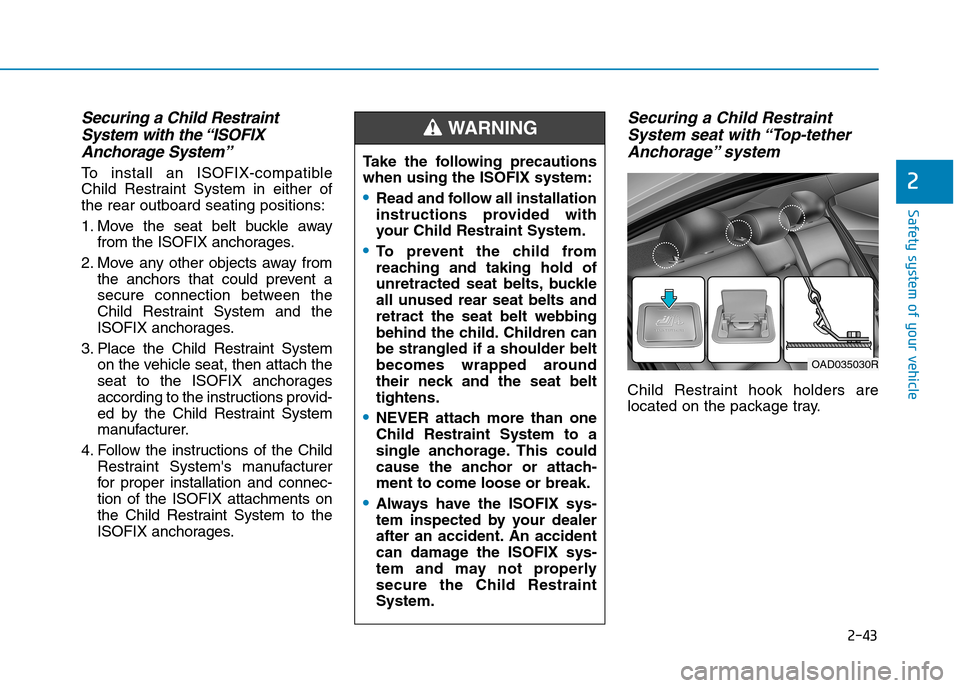
2-43
Safety system of your vehicle
2
Securing a Child Restraint
System with the “ISOFIX
Anchorage System”
To i n s t a l l a n I S O F I X - c o m p a t i b l e
Child Restraint System in either of
the rear outboard seating positions:
1. Move the seat belt buckle away
from the ISOFIX anchorages.
2. Move any other objects away from
the anchors that could prevent a
secure connection between the
Child Restraint System and the
ISOFIX anchorages.
3. Place the Child Restraint System
on the vehicle seat, then attach the
seat to the ISOFIX anchorages
according to the instructions provid-
ed by the Child Restraint System
manufacturer.
4. Follow the instructions of the Child
Restraint System's manufacturer
for proper installation and connec-
tion of the ISOFIX attachments on
the Child Restraint System to the
ISOFIX anchorages.
Securing a Child Restraint
System seat with “Top-tether
Anchorage” system
Child Restraint hook holders are
located on the package tray.
Ta k e t h e f o l l o w i n g p r e c a u t i o n s
when using the ISOFIX system:
•Read and follow all installation
instructions provided with
your Child Restraint System.
•To p r e v e n t t h e c h i l d f r o m
reaching and taking hold of
unretracted seat belts, buckle
all unused rear seat belts and
retract the seat belt webbing
behind the child. Children can
be strangled if a shoulder belt
becomes wrapped around
their neck and the seat belt
tightens.
•NEVER attach more than one
Child Restraint System to a
single anchorage. This could
cause the anchor or attach-
ment to come loose or break.
•Always have the ISOFIX sys-
tem inspected by your dealer
after an accident. An accident
can damage the ISOFIX sys-
tem and may not properly
secure the Child Restraint
System.
WA R N I N G
OAD035030R
Page 71 of 571
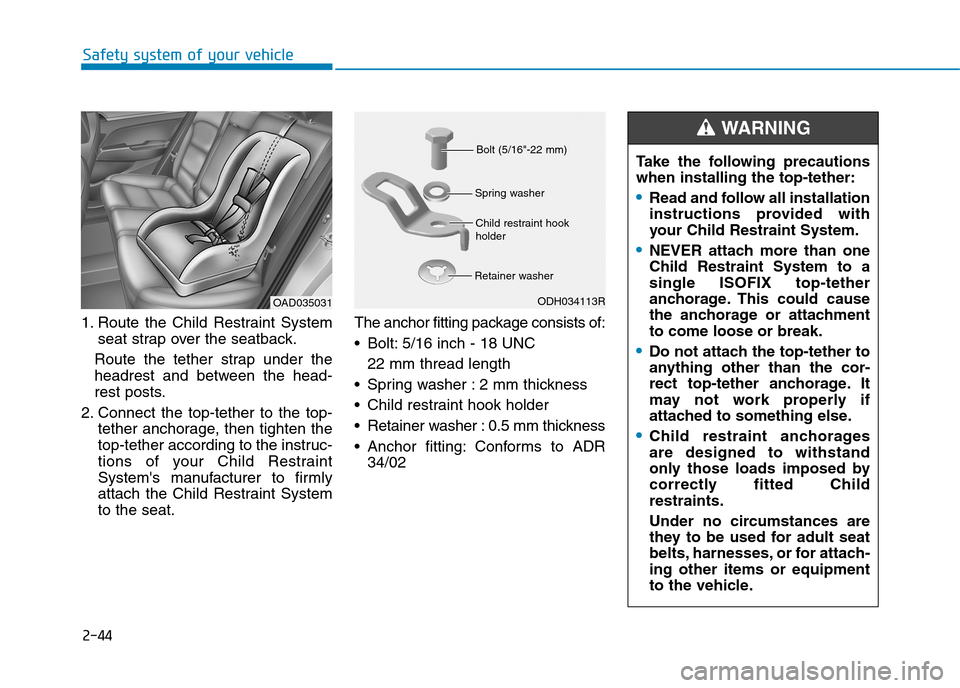
2-44
Safety system of your vehicle
1. Route the Child Restraint System
seat strap over the seatback.
Route the tether strap under the
headrest and between the head-
rest posts.
2. Connect the top-tether to the top-
tether anchorage, then tighten the
top-tether according to the instruc-
tions of your Child Restraint
System's manufacturer to firmly
attach the Child Restraint System
to the seat.
The anchor fitting package consists of:
•Bolt:5/16 inch - 18 UNC
22 mm thread length
•Spring washer :2 mm thickness
•Child restraint hook holder
•Retainer washer :0.5 mm thickness
•Anchor fitting:Conforms to ADR
34/02
OAD035031
Ta k e t h e f o l l o w i n g p r e c a u t i o n s
when installing the top-tether:
•Read and follow all installation
instructions provided with
your Child Restraint System.
•NEVER attach more than one
Child Restraint System to a
single ISOFIX top-tether
anchorage. This could cause
the anchorage or attachment
to come loose or break.
•Do not attach the top-tether to
anything other than the cor-
rect top-tether anchorage. It
may not work properly if
attached to something else.
•Child restraint anchorages
are designed to withstand
only those loads imposed by
correctly fitted Child
restraints.
Under no circumstances are
they to be used for adult seat
belts, harnesses, or for attach-
ing other items or equipment
to the vehicle.
WA R N I N G
Bolt (5/16"-22 mm)
Spring washer
Child restraint hookholder
Retainer washer
ODH034113R
Page 72 of 571
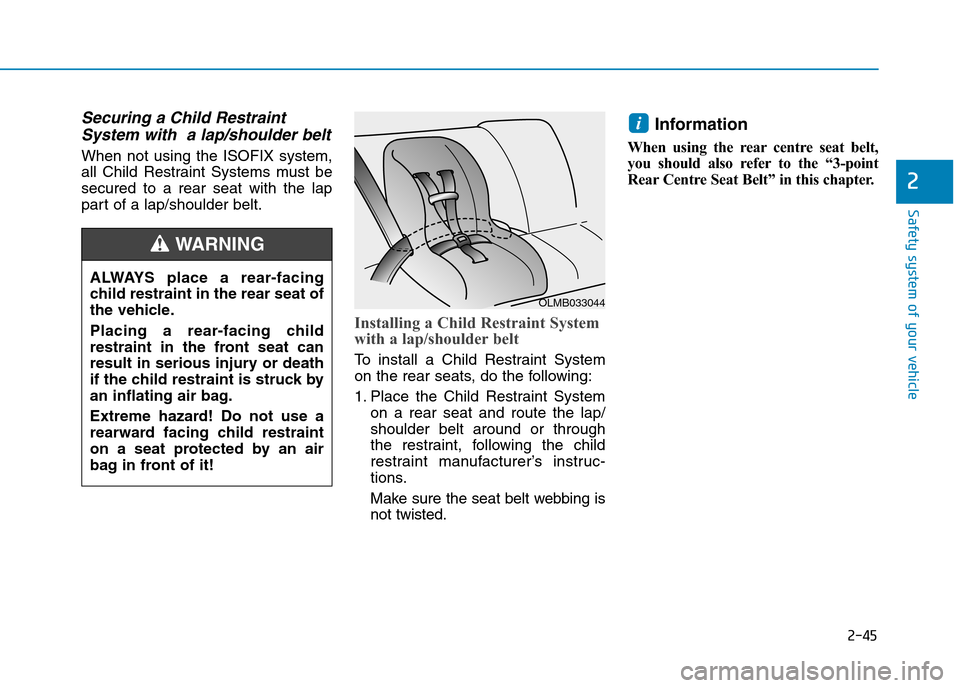
2-45
Safety system of your vehicle
2
Securing a Child Restraint
System with a lap/shoulder belt
When not using the ISOFIX system,
all Child Restraint Systems must be
secured to a rear seat with the lap
part of a lap/shoulder belt.
Installing a Child Restraint System
with a lap/shoulder belt
To i n s t a l l a C h i l d R e s t r a i n t S y s t e m
on the rear seats, do the following:
1. Place the Child Restraint System
on a rear seat and route the lap/
shoulder belt around or through
the restraint, following the child
restraint manufacturer’s instruc-
tions.
Make sure the seat belt webbing is
not twisted.
Information
When using the rear centre seat belt,
you should also refer to the “3-point
Rear Centre Seat Belt” in this chapter.
i
ALWAYS place a rear-facing
child restraint in the rear seat of
the vehicle.
Placing a rear-facing child
restraint in the front seat can
result in serious injury or death
if the child restraint is struck by
an inflating air bag.
Extreme hazard! Do not use a
rearward facing child restraint
on a seat protected by an air
bag in front of it!
WA R N I N G
OLMB033044